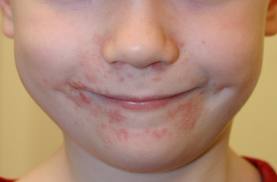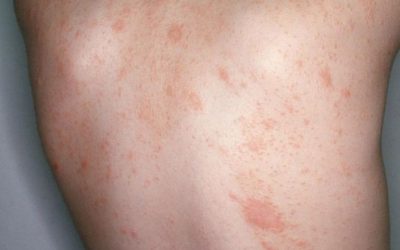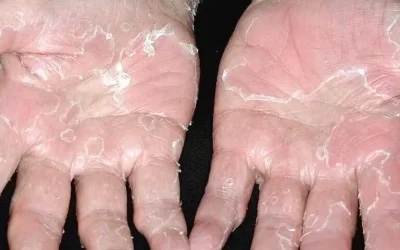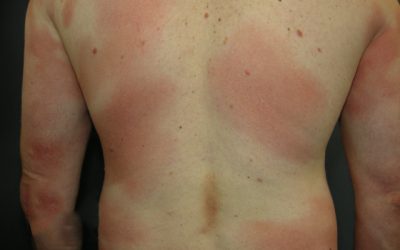Perioral Dermatitis

-
- Causes and mechanisms of the disease are not fully understood
- POD affects both children and adults, with a higher prevalence in those aged 16-45. Women are more affected then men.
- POD is more common in people with atopy (an inherited predisposition to allergic diseases)
Rash of perioral dermatitis:
-
- multiple clustered pink papules 1-2 mm
- vesicles
- bladders
- dandruff
- itching, burning, “stretching” may be felt
- the narrow area around the lips remains intact


-
- Topical (creams, ointments, nasal sprays, inhalers), systemic steroids (oral or injectable) in use or recently used
- Preparations with propolis
- Sunscreens
- Fluoride products (toothpaste, other dental products), chewing gum
- Ultraviolet (UV) light, heat, cold
- Hormonal changes (e.g. puberty, pregnancy, premenopause)
- Oral contraceptives
- Fusobacteria spp., Candida albicans colonisation, increase in Demodex mites
- Bacterial or viral infection
- Poorly chosen facial care products
Perioral dermatitis should also be differentiated from seborrhoeic dermatitis, allergic dermatitis, and bacterial or fungal skin infections.
The diagnosis of the disease usually requires a medical examination and an assessment of the risk factors that may have caused the rash. Laboratory tests are not informative and are not necessary for the diagnosis of POD. In very rare cases where treatment is ineffective over a long period of time, a skin biopsy is performed.
Treatment
-
- One of the most effective options for the comprehensive treatment of POD is zero therapy – the avoidance and elimination of all provoking factors.
- Medication treatment is individually tailored according to the severity of the disease, based on the patient’s medical history;
- Medication is not always prescribed;
Recommendations
-
- Until you see a doctor, stop all the provoking factors (mentioned above) that can cause and aggravate perioral dermatitis;
Choose only facial care products suitable for sensitive skin, without added irritants; - Each case of POD is highly individual, so it is recommended to consult a dermatovenereologist for confirmation of the diagnosis and treatment.
- Until you see a doctor, stop all the provoking factors (mentioned above) that can cause and aggravate perioral dermatitis;

Pityriasis rosea
An acute, self-limiting, exanthematic skin disease that manifests as itchy, somewhat inflammatory, scaly rashes, usually on the torso, chest, and upper limbs.
Peeling skin syndrome
Peeling skin syndrome is a genetic disorder characterized by constant peeling of the skin. The disease appears from birth or in the first year of life
lasts a lifetime
Mycosis Fungoides
The most common primary skin T-cell lymphoma (cancer of the blood). Mycosis Fungoides is characterized by three main stages, several of which may exist at the same time
iDerma
MB iDerma
Fabijoniškės g. 99, Vilnius
+370 670 70 822
[email protected]




